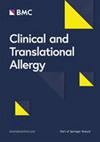Altered diversity and composition of gut microbiota in Korean children with food allergy
Abstract
Background
This study aimed to comprehensively characterize the gut microbiome and identify individual and grouped gut microbes associated with food allergy (FA) using 16S rRNA gene sequencing.
Methods
Fecal samples were collected from children with IgE-mediated FA and from sex- and age-matched controls. The V3–V4 variable regions of the 16S rRNA gene of the gut microbiome were profiled using next-generation sequencing (Illumina, USA). Bacterial species richness, intracommunity diversity, and intergroup dissimilarity were evaluated. Functional profiles were predicted using Phylogenetic Investigation of Communities by Reconstruction of Unobserved States (PICRUSt) and the Minimal Set of Pathways (MinPath) algorithm.
Results
Fecal samples were collected from children with IgE-mediated FA (n = 66) and from sex- and age-matched controls (n = 22). Gut microbiome richness (p < 0.0001), intra-community diversity (p < 0.0001), and inter-community diversity (p = 0.0004) were higher in the healthy group than in the FA group. Patients with FA were enriched in Blautia, Fusicatenibacter, and Ruminococcus_g5 compared with healthy control individuals (all p < 0.05). Healthy control individuals were significantly enriched in Oscillibacter and Ruminococcus compared with patients with FA (all p < 0.05). Functional pathway analysis identified enrichment in pathways related to endoglucanase in healthy controls and the ATP-binding cassette (ABC) transport system in FA patients.
Conclusions
The gut microbiomes of patients with FA and healthy control individuals had different taxonomic abundances, and the microbiome richness and diversity of the bacterial flora of patients with FA were reduced compared with controls.


 求助内容:
求助内容: 应助结果提醒方式:
应助结果提醒方式:


